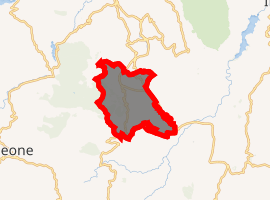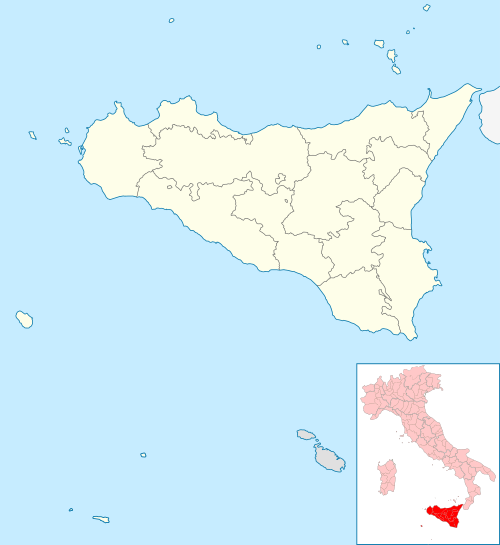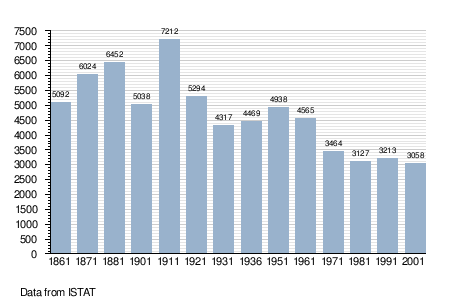Mezzojuso
Mezzojuso (Sicilian: Menzijusu or Menziuso,[3] Arbëreshë: Munxifsi[4]) is a comune (municipality) in the Metropolitan City of Palermo in the Italian region Sicily, located about 45 kilometres (28 mi) southeast of Palermo. As of 31 December 2004, it had a population of 3,003 and an area of 49.4 square kilometres (19.1 sq mi).[5]
Mezzojuso | |
|---|---|
| Comune di Mezzojuso | |
Location of Mezzojuso 
| |
 Mezzojuso Location of Mezzojuso in Italy  Mezzojuso Mezzojuso (Sicily) | |
| Coordinates: 37°52′N 13°28′E | |
| Country | Italy |
| Region | Sicily |
| Metropolitan city | Palermo (PA) |
| Area | |
| • Total | 49.4 km2 (19.1 sq mi) |
| Population (Dec. 2004)[2] | |
| • Total | 3,002 |
| • Density | 61/km2 (160/sq mi) |
| Time zone | UTC+1 (CET) |
| • Summer (DST) | UTC+2 (CEST) |
| Postal code | 90030 |
| Dialing code | 091 |
Mezzojuso borders the following municipalities: Campofelice di Fitalia, Cefalà Diana, Ciminna, Godrano, Marineo, Villafrati.
History
Mezzojuso means in Arabic: “Manzil Yusuf” (منزل يوسف) which translates in English to “Houses or ‘hamlet’ of Joseph”. It could also be translated into Italian, meaning "Halfway down" because the town is located halfway down the hill.
A small Saracen (Arab) settlement from about A.D. 10th Century, passed into Norman hands in 1091. Then the Christian population erected the small church of S. Maria delle Grazie. The town and all the neighboring area was granted by the Norman king Roger (Ruggerio) II, to the Monastery of Saint John the Hermit, of Palermo in 1132. The village was nearly depopulated in the early 15th century. The Monastery of Saint John granted settlement to 48 families of Albanian soldiers, under the command of Demetrius Reres.[6] The first Albanians who settled there were the said Reres with his two sons, leading three battalions of soldiers. King Alfonso of Aragon granted him permission to settle in the area and appointed D. Reres as a governor, with a decree of 1st Sept. 1448. Reres and his units had already served Alfonso and helped him to conquer Calabria, as Alfonso recognizes.[7]
The first settlers from the Balkans found the local church of Santa Maria delle Crazie ruined and soon rebuilt it. With a contract of 1501 with the Palermo religious authorities, they undertook the restoration of the church, the donation of olive oil and wax and everything needed for the rituals that had to be executed according to the Byzantine rite by priests. The community increased in population and by 1529 they established a fraternity.
The Reres family was one of the bigger of the community. Till the early 17th century, 11 persons with this name are noted in the archives. Apart from the aforementioned Demetrios, there were also Georgios and Basileios Reres (sons of Demetrios), Theodoros (in 1605 was captain of 452 stratioti (in Sicilian: "greci militari albanesi") in Mezzojuso, Loukas and Andreas, sons of Theodoros (officers, too), Agnes Rere (mother of Andreas), Andreas (the benefactor of the churches), Lucina (Andeas' wife) and Georgios (Latin catholic priest).
In 1601, the administrator was an Andrea Reres, a descendant of Demetrius Reres.[8] A. Reres died in 1609 and was buried in the church of S. Maria delle Grazie. A Latin and Greek inscription of 1752 in the church commemorates his name and the restoration works. In 1609, a Basilian monastery was founded by Reres with the provision that the Greek rite would be used.[8] In 1630, since there were no Basilian Albanian monks, eight monks from Crete were brought, causing the reaction of the local Italian nobility, which accused them as schismatics and false monks.[8] The monastery was abandoned by the mid 19th century.
Local life
The most significant local event happens before Easter, with the "Mastru Campu" ("maestro di campo" in Italian) which takes place on the last Sunday of Carnival, just before the start of Lent.
Reflecting the town's mixed ethnoreligious heritage, Mezzojuso is home to two historic Catholic mother churches both dating to the 16th century: the Latin-rite parish Church of Maria Santissima Annunziata and the Byzantine Greek-rite parish Church of San Nicolò di Mira.[9]
The municipality's economy is based mainly on the cultivation of traditional crops like hard wheat, sulla, and extra virgin olive oil, which is produced from old and new olives, and on the breeding of sheep, cattle and goats.
Demographic evolution

Notable people
- Nicola Figlia, folklorist and translator[10]
- GianLorenzo Perniciaro, Renaissance man
References
- "Superficie di Comuni Province e Regioni italiane al 9 ottobre 2011". Istat. Retrieved 16 March 2019.
- "Popolazione Residente al 1° Gennaio 2018". Istat. Retrieved 16 March 2019.
- George Dennis; John Murray (Firm) (1864). A handbook for travellers in Sicily: including Palermo, Messina, Catania, Syracuse, Etna, and the ruins of the Greek temples. J. Murray. pp. 218–. Retrieved 22 December 2011.
- Adam YAMEY (6 October 2014). FROM ALBANIA TO SICILY. Lulu.com. pp. 84–. ISBN 978-1-291-98068-4.
- All demographics and other statistics: Italian statistical institute Istat.
- Kellner, Heidrun (1972). Die albanische Minderheit in Sizilien. O. Harrassowitz. p. 42. ISBN 978-3-447-01384-0. Retrieved 3 February 2012.
- Siderides, p. 161,162:
- "Alfonso, Dei Gratia King of Aragon, of the Two Sicilies, Jerusalem etc ...
- To the noble stratioti Demetrio Reres, brave leader of the Epirotes, to my beloved and faithful, Our Royal Grace is granted ...
- ... We appreciate his military services and the pains of three military phalanx during their service and their sacrifice of blood for the conquest of the lower Calabria ...".
- Pipa, Arshi (1978). Albanian literature: social perspectives. R. Trofenik. p. 41. ISBN 978-3-87828-106-1. Retrieved 17 February 2012.
- "Guida ai Comuni (Communes Guide) - MEZZOJUSO" (PDF). Alto Belice Corleonese S.p.A. Retrieved May 15, 2018.
- Manoscritto inedito del papàs Andrea Figlia (1764) [Unpublished manuscript of papàs Andrea Figlia (1764)] (in Italian), JEMI- Il portale per gli Arbëreshë, retrieved 2016-01-31,
Dal Paese de Figliati, così chiamato, che oggi si vede spopolato da qualche era nel 1400 essendo stato un paese grandissimo, e di nobiltà che sempre ha prodotto, e produce all'Albania buona, e bellicosa Gioventù, lo chè dagl'Officiali del Regimento a loro confinanti vi si attesta. Ne venne dunque la detta famiglia oggi di Figlia, che la maggior parte di loro si è stabilita in Mezzojuso, porzione nella Piana, ed altri anche in Puglia.
Bibliography
- Buccola Onofrio (1909) La Colonia Greco-Albanese di Mezzojuso: origine, vicende e progresso.
- Buccola Onofrio (1912) Nuove recerche sulla fondazione della Colonia Greco-Albanese di Mezzojuso.
- Buccola Onofrio (1914) Mezzojuso e la Chiesa di Santa Maria: nuovi documenti storici.
- Siderides S.A. (1928) The epirotic family of Rere (Η Ηπειρωτίς οικογένεια Ρερέ), Epirotica Chronica (Ηπειρωτικά Χρονικά), vol.3, pp. 160–168. In Greek language.





